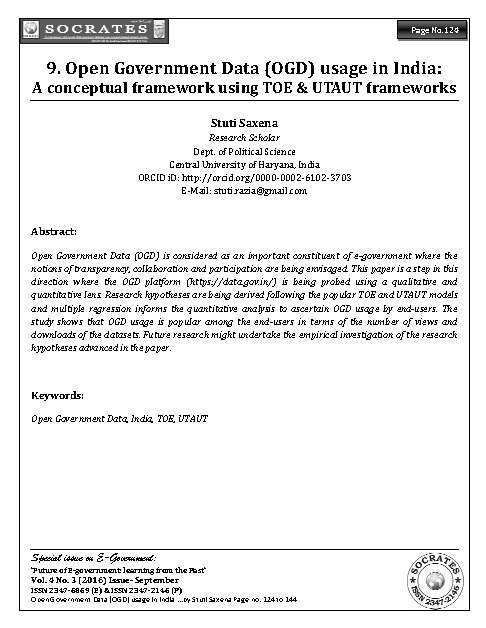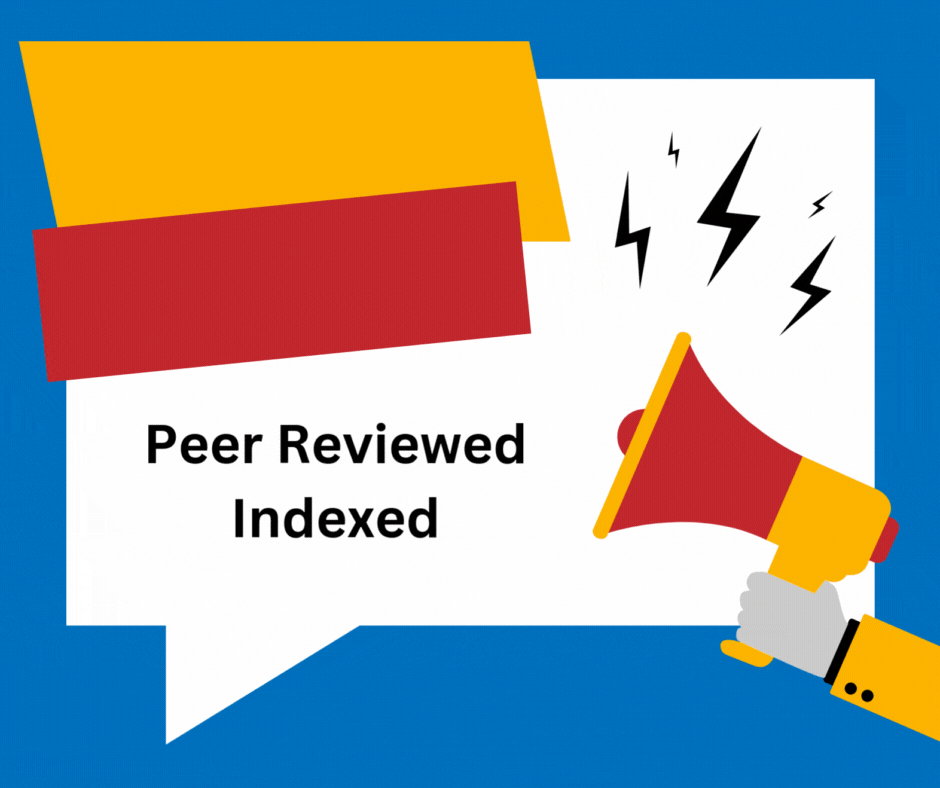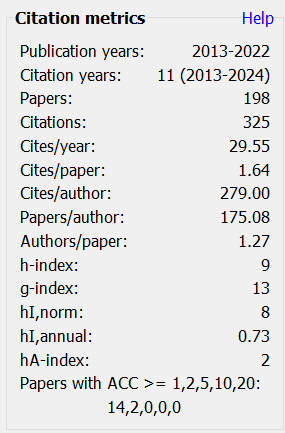Open Government Data (OGD) usage in India
A conceptual framework using TOE & UTAUT frameworks
Keywords:
Open Government Data, India, TOE, UTAUTAbstract
Open Government Data (OGD) is considered as an important constituent of e-government where the notions of transparency, collaboration and participation are being envisaged. This paper is a step in this direction where the OGD platform (https://data.gov.in/) is being probed using a qualitative and quantitative lens. Research hypotheses are being derived following the popular TOE and UTAUT models and multiple regression informs the quantitative analysis to ascertain OGD usage by end-users. The study shows that OGD usage is popular among the end-users in terms of the number of views and downloads of the datasets. Future research might undertake the empirical investigation of the research hypotheses advanced in the paper.
Downloads
Metrics
References
Allison, B. (2010). My data can't tell you that. In D. Lathrop, & L. Ruma (Eds.), Open government-Collaboration, transparency, and participation in practice (pp. 257-265). O'Reilly Media, Inc.
Attard, J., Orlandi, F., Scerri, S., & Auer, S. (2015). A systematic review of open government data initiatives. Government Information Quarterly. http://dx.doi.org/10.1016/j.giq.2015.07.006.
Bates, J. (2014). The strategic importance of information policy for the contemporary neoliberal state: The case of Open Government Data in the United Kingdom. Government Information Quarterly, 31, 388-395.
Bertot, J.C., Butler, B.S., & Travis, D. (2014). Local big data: The role of libraries in building community data infrastructures. 15th Annual International Conference on Digital Government Research, dg.o '14, Aguascalientes, Mexico, June 18-21, 2014 (pp. 17–23). http://dx.doi.org/10.1145/2612733.2612762.
Borglund, E. & Engvall, T. (2014). Open data?: Data, information, document or record? Records Management Journal, 24(2), 163-180.
Chan, C.M. (2013). From open data to open innovation strategies: Creating e-services using open government data. 2014 47th Hawaii International Conference on System Sciences (pp. 1890-1899).
Charalabidis, Y., Alexopoulos, C. & Loukis, E. (2016). A taxonomy of open government data research areas and topics. Journal of Organizational Computing and Electronic Commerce, 26(1/2), 41-63.
Chau, P. Y. K., & Tam, K. Y. (1997). Factors affecting the adoption of open systems: An exploratory study. MIS Quarterly, 21, 1-24.
Christian, E. (2001). A metadata initiative for global information discovery. Government Information Quarterly, 18(3), 209–221.
Chwelos, P., Izak, B., & Dexter, A. S. (2001). Research report: Empirical test of an EDI adoption model. Information Systems Research, 12(3), 304-321.
Conradie, P. & Choenni, S. (2014). On the barriers for local government releasing open data. Government Information Quarterly, 31, S10-S17.
Davies, T. (2010). Open data, democracy and public sector reform. A look at open government data use from data.gov.uk. Retrieved May 19, 2014, from http://www.opendataimpacts.net/report/
Davies, T. (2012). Supporting open data use through active engagement. W3C Using Open Data Workshop, available at: www.w3.org/2012/06/pmod/pmod2012_submission_5.pdf (accessed 28 April 2016).
Davies, T. G., & Bawa, Z. A. (2012). The promises and perils of Open Government Data (OGD). The Journal of Community Informatics, 8(2) [n.p].
Davis, F. D. (1989). Perceived usefulness, perceived ease of use, and user acceptance of information technology. MIS Quarterly, 13(3), 319-340.
Dawes, S.S., Vidiasova, L. & Parkhimovich, O. (2016). Planning and designing open government data programs: An ecosystem approach. Government Information Quarterly, 33, 15-27.
DiMaggio, P. J., & Powell,W.W. (1983). The iron cage revisited: Institutional isomorphism and collective rationality in organizational fields. American Sociological Review, 48(2), 147-160.
Ding, L., Peristeras, V., & Hausenblas, M. (2012). Linked open government data. Intelligent Systems, IEEE, 27(3), 11–15. http://dx.doi.org/10.1109/MIS.2012.56.
dos Santos Brito, K., dos Santos Neto, M., da Silva Costa, M. A., Garcia, V. C., & de LemosMeira, S. R. (2014). Using parliamentary Brazilian open data to improve transparency and public participation in Brazil. Proceedings of the 15th Annual International Conference on Digital Government Research (pp. 171–177). New York, NY, USA: dg.o '14,ACM. http://dx.doi.org/10.1145/2612733.2612769.
Evans, M. A, & Campos, A. (2013). Open government initiatives: Challenges of citizen participation. Journal of Policy Analysis and Management, 32(1), 172–185.
Feinberg, L. E. (2004). FOIA, federal information policy, and information availability in a post-9/11 world. Government Information Quarterly, 21(4), 439–460.
Fischer, F. (2012). Participatory governance: From theory to practice. In D. Levi-Faur (Ed.), The Oxford handbook of governance. Oxford: Oxford University Press.
Fishbein, M., & Ajzen, I. (1975). Belief, attitude, intention and behavior: An introduction to theory and research. Massachusetts: Addison-Wesley.
Gonzalez-Zapata, F. & Heeks, R. (2015). The multiple meanings of open government data: Understanding different stakeholders and their perspectives. Government Information Quarterly, 32, 441-452.
Gurstein, M. (2011), “Open data: empowering the empowered or effective data use for everyone?”, First Monday, 16.
Gwebu, K. L., &Wang, J. (2011). Adoption of open source software: the role of social identification. Decision Support Systems, 51(1), 220–229.
Huijboom, N., & Van den Broek, T. (2011). Open data: An international comparison of strategies. European Journal of EPractice, 1-13 (April).
Janssen, K. (2011). The influence of the psi directive on open government data: An overview of recent developments. Government Information Quarterly, 28(4), 446-456.
Janssen, M., Charalabidis, Y., & Zuiderwijk, A. (2012). Benefits, adoption barriers and myths of open data and open government. Information Systems Management, 29(4), 258-268.
Jeffery, K., Asserson, A., Houssos, N., Brasse, V., & Jörg, B. (2014). From open data to data intensive science through CERIF. Paper presented at the 12th International Conference on Current Research Information Systems, Rome, Italy.
Jetzek, T., Avital, M., & Bjorn-Andersen, N. (2012). The value of open government data: A strategic analysis framework. Paper presented at the SIG eGovernment pre-ICIS Workshop, Orlando.
Jetzek, T., Avital, M., & Bjorn-Andersen, N. (2014). Data-driven innovation through open government data. Journal of Theoretical and Applied Electronic Commerce Research, 9(2), 100–120.http://dx.doi.org/10.1007/978-3-662-43459-8_5.
Jetzek, T., Avital,M., & Bjørn-Andersen, N. (2014). Generating sustainable value fromopen data in a sharing society. In B. Bergvall-Kåreborn, & P. Nielsen (Eds.), Creating Value for All Through IT, IFIP Advances in Information and Communication Technology. 429. (pp. 62–82). Berlin Heidelberg: Springer.
Johnson, P.A., & Robinson, P.J. (2014). Civic hackathons: Innovation, procurement, or civic engagement? Review of Policy Research, 31(4), 349–357.
Jung, K., & Park, H. (2015). A semantic (triz) network analysis of South Korea's “open public data” policy. Government Information Quarterly, 32(3), 353-358.
Jurisch, M. C., Kautz, M., Wolf, P., & Krcmar, H. (2015). An international survey of the factors influencing the intention to use open government. Paper presented at the 48th Hawaii International Conference on System Sciences, Hawaii, U.S.A.
Kalampokis, E., Tambouris, E., & Tarabanis, K. (2011). A classification scheme for open government data: Towards linking decentralised data. International Journal of Web Engineering and Technology, 6(3), 266-285.
Kassen, M. (2013). A promising phenomenon of open data: A case study of the Chicago open data project. Government Information Quarterly, 30, 508-513.
Keen, J., Calinescu, R., Paige, R. & Rooksby, J. (2013). Big Data+Politics=Open Data: The case of health care data in England. Policy and Internet, 5(2), 228-243.
Kerschberg, B. (2011). Metadata, the freedom of information act, and government hypocrisy. Retrieved from. http://www.forbes.com/sites/benkerschberg/2011/04/11/metadatathe-freedom-of-information-act-and-government-hypocrisy.
King, R. D., Liakata, M., Lu, C., Oliver, S. G., & Soldatova, L. N. (2011). On the formalization and reuse of scientific research. Journal of The Royal Society Interface, 8(63), 1440–1448.
Kuan, K. K. Y., & Chau, P. Y. K. (2001). A perception-based model for EDI adoption in small businesses using a technology–organization–environment framework. Information Management, 38(8), 507-521.
Kucera, J., & Chlapek, D. (2014). Benefits and risks of open government data. Journal of Systems Integration, 1, 30-41.
Lee, G., & Kwak, Y. H. (2012). An open government maturity model for social media-based public engagement. Government Information Quarterly, 29(4), 492–503.
Lee, J.A. (2013). ‘Can you hear me now?’ Making participatory governance work for the poor. Harvard Law & Policy Review, 7.
Linders, D. (2013). Towards open development: Leveraging open data to improve the planning and coordination of international aid. Government Information Quarterly, 30, 426-434.
Lourenço, R. P. (2015). An analysis of open government portals: A perspective of transparency for accountability. Government Information Quarterly, 32(3), 323–332.
Martin, C. (2014). Barriers to the open government data agenda: taking a multi-level perspective. Polymer International, 6(3), 217–240. http://dx.doi.org/10.1002/1944-2866.POI367.
Mclaren, R., & Waters, R. (2011). Governing location information in the UK. The Cartographic Journal, 48(3), 172–178.
Mutuku, L.N., & Colaco, J. (2012). Increasing Kenyan open data consumption: A design thinking approach. Proceedings of the 6th International Conference on Theory and Practice of Electronic Governance (pp. 18–21). New York, NY, USA: ICEGOV '12, ACM. http://dx.doi.org/10.1145/2463728.2463733.
Nugroho, R.P., Zuiderwijk, A., Janssen, M. & de Jong, M. (2015). A comparison of national open data policies: Lessons learned. Transforming Government: People, Process and Policy, 9(3), 286-308.
OGP (2015). Chile. San Francisco, CA: Open Government Partnership (http://www.opengovpartnership.org/country/chile).
Ohemeng, F.L.K. & Ofosu-Adarkwa, K. (2015). One way traffic: The open data initiative project and the need for an effective demand side initiative in Ghana. Government Information Quarterly, 32, 419-428.
Parycek, P., & Sachs, M. (2010). Open government-Information flow in web 2.0. European Journal of ePractice, 9, 1–12.
Parycek, P., Hochtl, J., & Ginner, M. (05 2014). Open government data implementation evaluation. Journal of Theoretical and Applied Electronic Commerce Research, 9, 80–99.
Petychakis, M., Vasileiou, O., Georgis, C., Mouzakitis, S., & Psarras, J. (2014). A state-of-the-art analysis of the current public data landscape froma functional, semantic and technical perspective. Journal of Theoretical and Applied Electronic Commerce Research, 9(2), 34–47.
Premkumar, G., & Roberts, M. (1999). Adoption of new information technologies in rural small businesses. Omega, 27(4), 467-484.
Quam, E. (2001). Informing and evaluating a metadata initiative: Usability and metadata studies in Minnesota's Foundations Project. Government Information Quarterly, 18(3), 181–194.
Raman, B. (2012). The rhetoric and reality of transparency: transparent information, opaque city spaces and the empowerment question. The Journal of Community Informatics, 8(2) [n.p.].
Rogers, E.M. (1995). Diffusion of innovations (4th ed.). New York: Free Press.
Rojas, L., Bermúdez, G., & Lovelle, J. (2014). Open data and big data: A perspective from Colombia. In L. Uden, D. Fuenzaliza Oshee, I.H. Ting, & D. Liberona (Eds.), Knowledge Management in Organizations, Lecture Notes in Business Information Processing. 185. (pp. 35-41). Springer International Publishing. http://dx.doi.org/10.1007/978-3-319-08618-7_4.
Sandoval-Almazan, R. & Gil-Garcia, J.R. (2016). Toward an integrative assessment of open government: Proposing conceptual lenses and practical components. Journal of Organizational Computing and Electronic Commerce, 26(1/2), 170-192.
Saxby, S. (2011). Three years in the life of UK national information policy-The politics and process of policy development. International Journal of Private Law, 4(1/2), 1–31.
Sheffer Correa, A., Correa, P., Silva, D., & Soares Correa da Silva, F. (June 2014). Really opened government data: A collaborative transparency at sight. Big Data (BigData Congress), 2014 IEEE International Congress on (pp. 806–807).
Sieber, R.E. & Johnson, P.A. (2015). Civic open data at a crossroads: Dominant models and current challenges. Government Information Quarterly, 32, 308-315.
Solar, M., Concha, G., & Meijueiro, L. (2012). A model to assess open government data in public agencies. In H.J. Scholl, M. Janssen, M. Wimmer, C.E. Moe, & L.S. Flak (Eds.), EGOV. Lecture Notes in Computer Science. 7443. (pp. 210–221). Springer [http://dblp.uni-trier.de/db/conf/egov/egov2012.html#SolarCM12].
Srivastava, S. C., & Teo, T. S. H. (2010). E-government, e-business, and national economic performance. Communications of the Association for Information Systems, 26, 267-286.
Strickland, L. S. (2005). The information gulag: Rethinking openness in times of national danger. Government Information Quarterly, 22(4), 546–572.
Susha, I., Gronlund, A. & Janssen, M. (2015). Organizational measures to stimulate user engagement with open data. Transforming Government: People, Process and Policy, 9(2), 181-206.
Sykes, T. A., Venkatesh, V., & Gosain, S. (2009). Model of acceptance with peer support: a social network perspective to understand employees' system use. MIS Quarterly, 33(2), 371–393.
The White House (2016). Digital government. Building a 21st century platform to better serve the American people. Retrieved April 26, 2012, from http://www.whitehouse.gov/sites/default/files/omb/egov/digital-government/digital-government.html.
The World Bank (2014). Open data for economic growth: Transport & ICT global practice. Washington DC: The World Bank Press.
Tornatzky, L. G., & Fleischer, M. (1990). The processes of technological innovation. Lexington, MA: Lexington Books.
Ubaldi, B. (2013). Open government data: Towards empirical analysis of open government data initiatives. OECD Working Papers on Public Governance, No. 22, OECD Publishing. Accessed May 23, 2014. doi:10.1787/5k46bj4f03s7-en .
Vasa,M., & Tamilselvam, S. (2014). Building apps with open data in India: An experience. Proceedings of the 1st International Workshop on Inclusive Web Programming -Programming on the Web with Open Data for Societal Applications (pp. 1–7). New York, NY, USA: IWP 2014, ACM. http://dx.doi.org/10.1145/2593761.2593763.
Veljkovic, N., Bogdanovic-Dinic, S., & Stoimenov, L. (2014). Benchmarking open government: An open data perspective. Government Information Quarterly, 31(2), 278-290.
Venkatesh, V.,Morris, M. G., Davis, G. B., & Davis, F. D. (2003). User acceptance of information technology: Toward a unified view. MIS Quarterly, 27(3), 425-477.
Verma, N., & Gupta, M. P. (2012, 29–30 December). Open government data : more than eighty formats. Paper presented at the 9th International Conference on E-Governance (ICEG 2012), Cochin, Kerala, India.
Vetro, A., Canova, L., Torchiano, M., Minotas, C.O., Iemma, R. & Morando, F. (2016). Open data quality measurement framework: Definition and application to Open Government Data. Government Information Quarterly, doi: http://dx.doi.org/10.1016/j.giq.2016.02.001
Wang, H.J., & Lo., J. (2016). Adoption of open government data among government agencies. Government Information Quarterly, 33, 80-88.
Whitmore, A. (2012). Extracting knowledge from U.S. Department of Defense freedom of information act requests with social media. Government Information Quarterly, 29(2), 151-157.
Whitmore, A. (2014). Using open government data to predict war: A case study of data and systems challenge. Government Information Quarterly, 31, 622-630.
Wirtz, B.W. & Birkmeyer, S. (2015). Open government: Origin, development, and conceptual perspectives. International Journal of Public Administration, 38, 381-396.
Wirtz, B.W., Piehler, R., Thomas, M. & Daiser, P. (2015). Resistance of public personnel to open government: A cognitive theory view of implementation barriers towards open government data. Public Management Review. doi: 10.1080/14719037.2015.1103889
Yang, Z., & Kankanhalli, A. (2013). Innovation in government services: The case of open data. Grand Successes and Failures in IT. Public and Private Sectors – IFIP WG 8.6 International Working Conference on Transfer and Diffusion of IT, TDIT 2013, Bangalore, India, June 27–29, 2013. Proceedings. (pp. 644–651). http://dx.doi.org/10.1007/978-3-642-38862-0_47.
Yang, Z., Sun, J., Zhang, Y., &Wang, Y. (2015). Understanding SAAS adoption from the perspective of organizational users: A tripod readiness model. Computers in Human Behavior, 45, 254-264.
Yishai, Y. (2012). Participatory governance in public health: Choice, but no voice. In D. Levi-Faur (Ed.), The Oxford handbook of governance. Oxford: Oxford University Press.
Zeleti, F.A., Ojo, A. & Curry, E. (2016). Exploring the economic value of open government data. Government Information Quarterly, doi. http://dx.doi.org/10.1016/j.giq.2016.01.008
Zuiderwijk, A., & Janssen, M. (2014). Open data policies, their implementation and impact: A framework for comparison. Government Information Quarterly, 31(1), 17-29.
Zuiderwijk, A., Janssen, M. & Dwivedi, Y.K. (2015). Acceptance and use predictors of open data technologies: Drawing upon the unified theory of acceptance and use of technology. Government Information Quarterly, 32, 429-440.
Zuiderwijk, A., Janssen, M. & Susha, I. (2016). Improving the speed and ease of open data through metadata, interaction mechanisms, and quality indicators. Journal of Organizational Computing and Electronic Commerce, 26(1/2), 116-146.
Zuiderwijk, A., Janssen, M., Choenni, S., Meijer, R., & Alibaks, R. S. (2012). Socio-technical impediments of open data. Electronic Journal of e-Government, 10(2), 156-172.

Downloads
Published
How to Cite
Issue
Section
License
Revised Copyright/CC license that applies to all the articles published after 05-02-2017
Attribution-NonCommercial 4.0 International (CC BY-NC 4.0)

Copyright/CC license that applies to all the articles published before 05-02-2017
Attribution-Non Commercial-No Derivatives 4.0 International (CC BY-NC-ND 4.0)

Author(s) will retain all the right except commercial and re-publishing rights. In the case of re-publishing, they will have to obtain written permission from the journal. Additional licensing agreements (Creative Commons licenses) grants rights to readers to copy, distribute, display and perform the work as long as you give the original author(s) credit, they can not use the works for commercial purposes and are not allowed to alter, transform, or build upon the work. For any reuse or distribution, readers and users must make clear to others the license terms of this work. Any of these conditions can be waived if you get permission from the copyright holders. Nothing in this license impairs or restricts the authors’ rights. To view a copy of this license, visit http://creativecommons.org/licenses/by-nc-nd/4.0/ or send a letter to Creative Commons, 171 Second Street, Suite 300, San Francisco, California, 94105, USA.
Research Papers published in SOCRATES are licensed under an Attribution-NonCommercial-NoDerivatives 4.0 International (CC BY-NC-ND 4.0)












